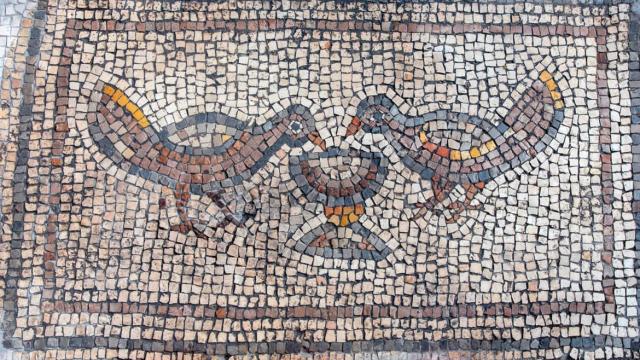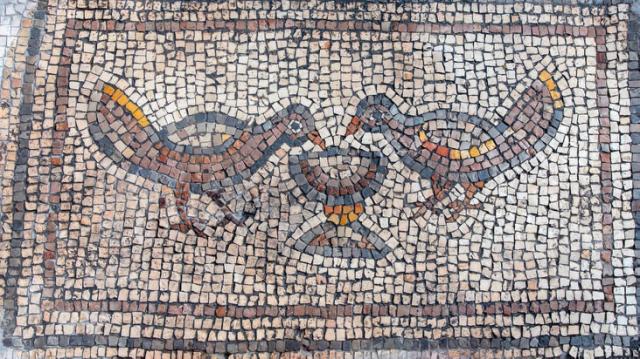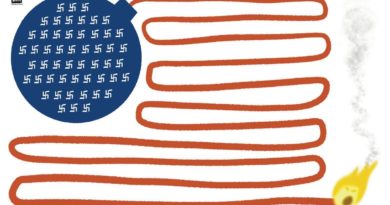M.E.: News Have Archaeologists Found Where Jesus Fed the 5,000?
University of Haifa
.

Archaeologists excavating near the Sea of Galilee may have discovered the site where Jesus is said to have miraculously fed a crowd of five thousand people using only five loaves and two fish. The miracle, which is mentioned in all four of the canonical Gospels, is regarded by some historians as one of the more ancient traditions associated with Jesus.
The new claim is based on discoveries made by scientists from the University of Haifa. During excavations at the Byzantine era “Burnt Church” in the Hippos National Park (the church is named because it was one of seven churches destroyed as part of the Sasanian conquest in 614 CE). Archaeologists uncovered a 1,400 year old mosaic on the floor of the church that depicts the feeding miracle.
–THIS SPACE BELOW IS RESERVE FOR YOUR ADVERTISEMENT –

According to the Gospel of Mark, Jesus and his disciples withdrew to a “deserted place” in the Galilee region after the death of John the Baptist in order to rest (Mark 6:31). The location must have been relatively close to the shore of the Sea of Galilee because they used a boat to get there. Once the group came ashore they were swamped by a crowd of people who had followed them there. The ever-practical disciples advised Jesus to send the crowd away as it was growing late and there was nothing for people to eat.
The miracle that follows is by biblical standards a rather low-key affair. Jesus had the disciples gather up the nutritional resources of the group. Then, Jesus looked up to heaven, blessed and broke the bread, and had the loaves and fishes evenly distributed among the people. “And all ate and were filled; and they took up twelve baskets full of broken pieces and of the fish. Those who had eaten the loaves numbered five thousand men.” (Mark 6:42-44). The story is repeated in Matthew, Mark, and John. There’s even a similar incident in Mark and Matthew known as the Feeding of the Four Thousand and even more food is left over.
–THIS SPACE BELOW IS RESERVE FOR YOUR ADVERTISEMENT –


Traditionally, people have believed that the feeding of the five thousand miracle took place in Tabgha, Capernaum, on the northwest shore of the Sea of Galilee. There’s even a church there, called the Church of the Multiplication, that celebrates the event. The earliest evidence of Christian worship in Tabgha dates to the mid-fourth century but the mosaics that refer to the feeding of the five thousand come from around 480 A.D.
Hippos, the site of the newest discovery, is on the southeastern shore of the Sea of Galilee. The history of the city there dates back to the turn of the era and there’s some evidence of occupation there as early as the third century B.C. There are several mosaics from the Burnt Church that appear to refer to the miracle story. The first depicts Jesus performing the miracle; the second shows twelve baskets filled with bread and fruit. Dr. Michael Eisenberg, who oversaw the excavation on behalf of the University of Haifa, noted that these may be a reference to the baskets of bread that were left over after the multitude had eaten.
–THIS SPACE BELOW IS RESERVE FOR YOUR ADVERTISEMENT –

Eisenberg cautiously hypothesized that perhaps Hippos was the place that the miracle supposedly took place. He toldThe Jerusalem Post:“Nowadays, we tend to regard the Church of the Multiplication in Tabgha on the northwest of the Sea of Galilee as the location of the miracle, but with careful reading of the New Testament, it is evident that it might have taken place north of Hippos within the city’s region.” If Eisenberg’s theory is correct this would mean that Christians had been, to borrow a phrase from Indiana Jones, celebrating the miracle ‘in the wrong place.’
Before jumping to conclusions, however, it is important to evaluate precisely what kinds of evidence we have for both the site in Hippos and that in Tabgha. Both sites contain mosaics of the miracle of the multiplication and these mosaics (and the churches that contained them) date to the fifth century.
–THIS SPACE BELOW IS RESERVE FOR YOUR ADVERTISEMENT –

The earliest evidence for Christians visiting any site associated with the miracle comes from the Pilgrimage diary of Christianity’s first female travel writer, Egeria, who visited the Holy Land ca. 381 A.D. According to her diary, the site she visited, “where the Lord fed the people with the five loaves and the two fishes” was near Capernaum. Even if the Church of the Multiplication is the same place visited by Egeria (and it is likely to be in the general vicinity), she was still traveling some 350 years after Jesus is reported to have performed this miracle. None of the archaeological or literary evidence can confirm either that the miracle took place, or where it took place.
What we do have evidence for is a trend in the artistic and theological program of late fifth century Christians living in the Holy Land. Whether or not those who commissioned the mosaics intended to claim that this was where the feeding miracle was performed, they are both very interested in this story about the divine provision of food. (Interestingly the artist who produced the mosaic in Tabgha was not a local fisherman: the mosaics there show the fish with two dorsal fins while fish from the Sea of Galilee only have one dorsal fin).
–THIS SPACE BELOW IS RESERVE FOR YOUR ADVERTISEMENT –

Both these churches were constructed during a period in which Christians made pilgrimages to religious sites looking for the alleviation of physical suffering. This suffering was usually related to sickness but people also asked for help with the hardships that resulted from crop failure, famine, taxation, and conflict. Perhaps what we have here are different religious centers that competed for and catered to the needs of pilgrims and tourists. These churches might have been equally appealing to members of the local fishing industry, who relied upon good hauls of fish in order to sustain themselves and their families. Bread and fish are evocative symbols for early Christians, but, for those who lived around the Sea of Galilee or were agrarian workers they also had a great deal of practical economic significance.
Equally, the discovery of multiple churches claiming a connection to the feeding of the five thousand story might just be directing us to the importance of food in ancient religion and religion in general. We tend to define religion as about religious books and prayers, but food has often played an important role in our relationship with the cosmic and supernatural order. As Meredith Warren, a lecturer at the University of Sheffield and author ofFood and Transformation in Ancient Mediterranean Literature, told the Daily Beast “Eating is one of the most fundamental ways that humans interact with the world, so it is no surprise that food and meals feature so prominently in the creation of meaning by early Christians.”
–THIS SPACE BELOW IS RESERVE FOR YOUR ADVERTISEMENT –

Have we discovered where the feeding of the 5000 actually took place (assuming that you believe that it happened)? Probably not. But archaeologists may well have unearthed another location where Christians genuinely believed Jesus had performed this miracle and remembered and commemorated that event. The discovery of these new mosaics can tell us a great deal about was important to Christians living in the region, the Bible stories that appealed to them, and the ways that various religious centers competed with each other.News
–THIS SPACE BELOW IS RESERVE FOR YOUR ADVERTISEMENT –











